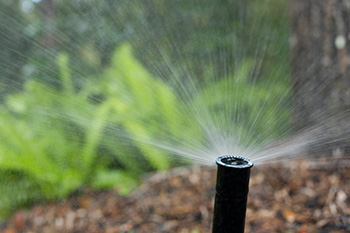Top 10 Landscaping Mistakes
It’s easy to find what you should do when designing your landscape, but it’s also important to be aware of what not to do. Below is a list of the top ten landscaping mistakes that unfortunately can be seen throughout the state. Don’t worry if you’ve made any of these mistakes; you have the tools to fix them!
1. Putting the wrong plant in the wrong place
If only landscaping was as easy as putting a plant where it looks nice. Instead, the light, moisture, and soil conditions of the planting location need to match the plant’s needs. For example, hydrangeas love shade and soil that is rich and well drained. If the desired planting location is full sun, high in clay, and tends to stay wet, your hydrangea will quickly deteriorate. Choosing the right plant for the right place from the start will allow you to avoid the costly trial-and-error approach to plant selection.
2. Failing to prepare the site before planting
This is especially problematic when installing landscaping at a newly constructed site. “Construction soil” around the foundation of newly built houses can contain concrete, paint, adhesives, and grout. This type of soil needs to be prepared or amended before planting. The site also needs to be graded for proper drainage. You’ll want to grade the slope away from the house and direct water into swales or redirect water with in-ground drain pipes. This will prevent drainage problems down the road.

3. Planting without considering the plant’s mature size
This mistake goes hand in hand with “wrong plant, wrong place.” The plant you pick up from the nursery may be the right size at the time, but it likely won’t stay that way. Make sure you research the max height and width for each plant you are considering and allow space for it to grow. This also applies to distance between plants; you’ll want to space them far enough apart that they won’t be crowded once mature. Additionally, we often see plants that have been excessively pruned to keep a certain shape or size (crape murder is an excellent example). Not only does this make maintenance more difficult, but this practice can also be detrimental to plant health. If you have a certain size/shape of tree or shrub in mind, select a plant that will reach your desired dimensions at maturity without unnecessary pruning.
4. Unknowingly planting invasives
Unfortunately, not all nurseries are responsible about keeping invasive plants off their shelves. You can easily check the invasive status for each plant you find by looking it up on the UF/IFAS Assessment of Non-Native Plants in Florida’s Natural Areas: https://assessment.ifas.ufl.edu/. Alternately, you can shop at native nurseries to avoid this issue entirely. Research now will help prevent invasive plants from taking over your yard in the future.
5. Lack of theme
A successful landscape design will have a consistent theme. Without a theme to unify the landscape, it can look messy and disorganized. Your theme can be as simple as choosing to follow a general shape or form, or as complex as a building a Mediterranean garden. This Ask IFAS publication has more information on selecting the right theme for your landscape: Landscape Design: Finding Inspiration for a Design Theme.

6. Forgetting resource efficiency
A higher-than-ever water bill can dampen the excitement of a newly installed landscape. Choosing drought-tolerant plants can lower the amount of water required, perhaps to the point where no supplemental irrigation is needed. Other inputs should be considered as well. Will this plant likely require fertilization or pest protection? Selecting low-maintenance plants that require few to no inputs will lessen the amount of time you spend working in the garden and cut costs.
7. Choosing the wrong groundcover
Turfgrass is often thought of as the default groundcover, but it isn’t ideal for every situation. For instance, it is not recommended for shady spots, on steep slopes, or in small areas that are difficult to maintain. An alternate groundcover should be used in these situations. There are options for every site condition, and often these groundcovers are less resource intensive and require less maintenance.
8. Planting too close to your foundation

Dr. Gail Hansen, UF/IFAS.
It can be tempting to plant right up to the foundation of your house, but this is not the best practice. This doesn’t allow enough room for the plant to grow, which leads to the mistake of excessive pruning. It also makes maintaining your home more difficult. In addition, pest problems are exacerbated because of reduced airflow. Instead, plant shrubs beyond the roof drip line.
9. Not designing with maintenance in mind
Sadly, aesthetically pleasing doesn’t always equate to low maintenance. For example, trendy curved pathways give a playful feel to the landscape, but they are difficult to mow around. Narrow strips of turf or scattering trees far apart instead of planting them in islands also makes mowing tough. Similarly, you can use multiple types of mulch in a bed to make designs, but that will be much harder to maintain than using a single mulch type. You should certainly be creative with your landscape design, but don’t forget about maintenance.
10. Replacing groundcovers with rock or artificial turf

For those who want a low-maintenance landscape, replacing groundcovers with rock or artificial turf seems like a great idea. However, these replacements don’t support wildlife and significantly increase heat in your yard. Many HOA landscape codes also don’t allow gravel or artificial turf. Instead, choose groundcovers that don’t require much maintenance. Many groundcovers also support pollinators and improve the soil, unlike rock or artificial turf.
We hope you will keep these common mistakes in mind as you design your landscape! As always, the experts at your county Extension office are there for you if you have any questions.
Also on Gardening Solutions
- Design: Types of Gardens
- The Nine Principles of Florida-Friendly Landscaping™
- Ten Important Things to Consider When Planning Your Landscape Design
